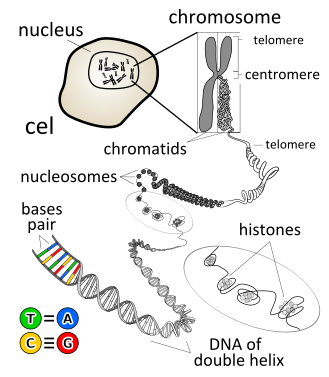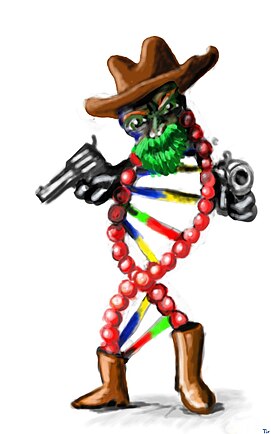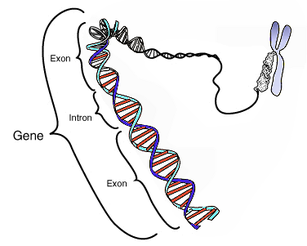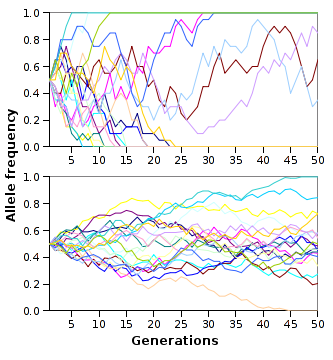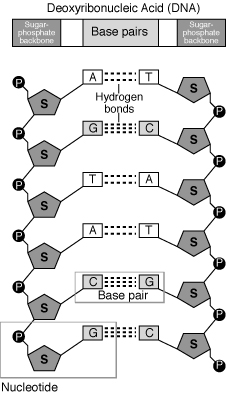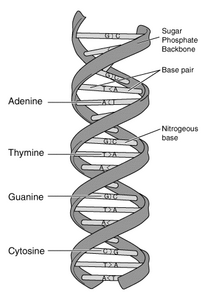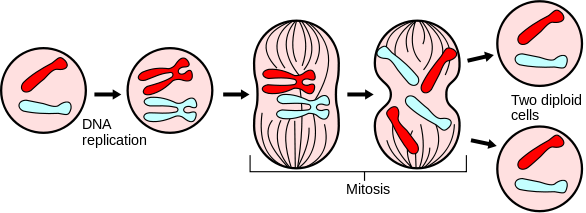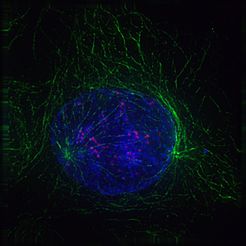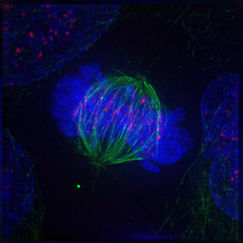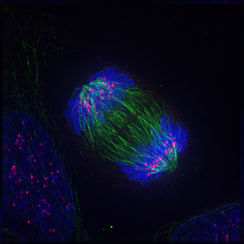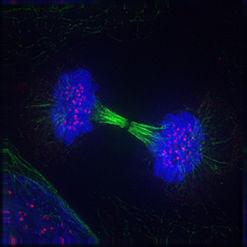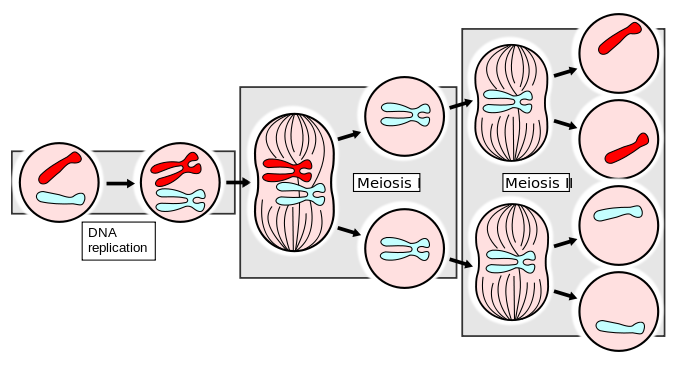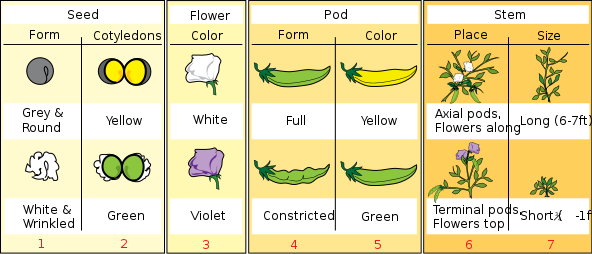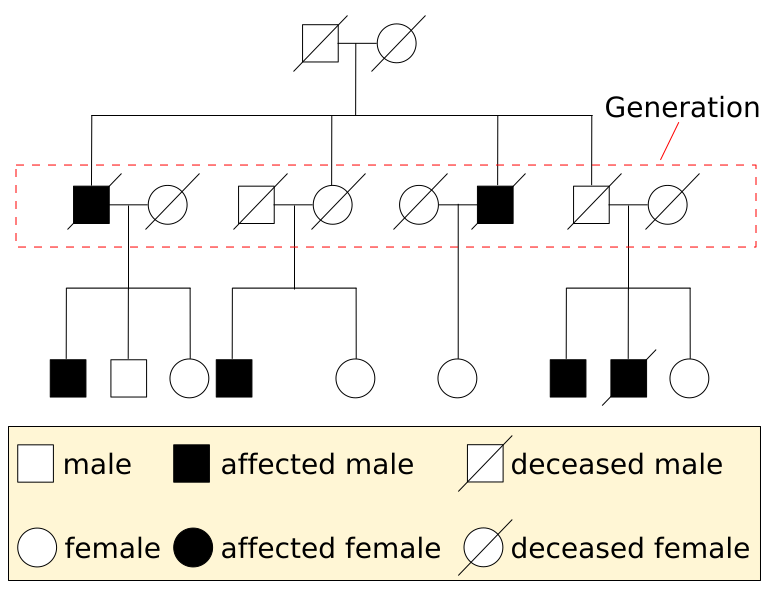Tshaw Ashs School Nz/Books/Science
In science...
Contents
- 1 Introduction
- 2 Biology
- 2.1 Genetics
- 2.1.1 Chromosomes
- 2.1.2 Genes
- 2.1.3 Alleles
- 2.1.4 Structure of DNA
- 2.1.5 DNA Replication & Interphase
- 2.1.6 Cell Division - Mitosis
- 2.1.7 Cell Division - Meiosis
- 2.1.8 Types of Variation
- 2.1.9 Gregor Mendel
- 2.1.10 Punnett Squares
- 2.1.11 Pedigree Charts
- 2.1.12 Applications of Genetics - Selective Breeding
- 2.1.13 Applications of Genetics - Cloning
- 2.1.14 Applications of Genetics - Genetic Manipulation
- 2.1.15 Glossary
- 2.1.16 References
- 2.1 Genetics
Introduction
Biology
Genetics
Chromosomes
A chromosome is a length of D.N.A. consisting of many genes.
- A chromosome is made up of gene regions which form the traits of an organism.
- A single chromosome is called a haploid, where as a pair of chromosomes (shown left) is known as diploid.
- The human haploid number is 23 (n=23), and the human diploid number is 46 (2n=46).
- Chromosomes usually come in homologous pairs, meaning the two chromosomes are:
~ the same size,
~ the centromere is in the same place on both,
~ the genes are in the same place on both (each gene is at the same locus).
In all human body cells there are...
One set of chromosomes from the father ... and one set of chromosomes from the mother
X chromosome Y chromosome Two X chromosomes
- Non-sex chromosomes are known as autosomes – they are all of the numbered chromosomes (other than X and Y).
Genes
- A gene is the fundamental unit of inheritance, which codes for a protein.
- Gene pools are all of the genes in a population. When genetic variation takes place, it affects the gene pool.
Alleles
- An allele is one of a number of forms that a gene can take. These can be dominant or recessive.
- The allele frequency is a measure of the commonness of an allele in a population (gene pool), as a percentage of that population. These can be graphed against eachother over generations:
- Allele frequencies show the amount of genetic variation in a gene pool. This is important to know, because if there is a low amount of variation in a gene pool and a gene is lost, it can be detrimental the longevity of that gene pool.
Structure of DNA
- DNA is made up of two polynucleotides wrapped around eachother, in what we know as a double helix.
- Polynucleotides are chains of linked nucleotides:
- These are made up of: a base - adenine (A), guanine (G), cytosine (C), or thymine (T)\
: a sugar - deoxyribose
: a nitrogenous base
- The complementary base pairing rule means that adenine pairs with thymine, and guanine pairs with cytosine.
FUNCTIONS OF DNA
- carries genetic material.
- can replicate itself so the cell can continue to function normally.
- carries genes which code for polypeptide chains, which join to form proteins.
DNA Replication & Interphase
DNA REPLICATION is just as the title explains, the replication of a DNA molecule. This happens before cell divisions (meiosis or mitosis).
THE PROCESS OF DNA REPLICATION:
- The double helix begins to unwind as hydrogen bonds between complementary base pairs are broken.
- The bases are now exposed, so pair with new nucleotides according to the complementary base pairing rule.
- Two daughter DNA molecules are formed, each with one old strand and one new strand formed exactly the same as the old one. This is called semi-conservative replication.
- Rarely, mistakes occur in base-pairing, causing mutation which can cause health problems in the affected animal.
INTERPHASE
- DNA replication is the main part of the interphase - the phase between cell divisions.
- The interphase is divided into 3 phases:
1. Growth 1 - regular cell growth
2. Synthesis - DNA replication
3. Growth 2 - number of organelles doubles
Cell Division - Mitosis
Mitosis replenishes our dying cells by producing identical cells in their place.
The new cells must have the same amount of chromosomes and organelles - they are produced by mitosis.
Mitosis happens after DNA replication, and produces two diploid cells from one.
Mitosis happens in stages:
- Prophase - After DNA replication the chromosomes shorten and become visible. The spindle (made up of protein fibres) forms.
- Metaphase - Chromsomes are attached to the spindle fibres and are arranged in a line on the equator of the spindle.
- Anaphase - Chromatids from each chromosome are pulled apart to either end of the spindle, and the membrane begins to close and part in the centre (beginning of the formation of two cells).
- Telophase - The spindle disappears and the cytoplasm fully divides (known as cytokinesis), forming two cells. The chromosomes elongate and become indistinct again.
This is the full cycle:
Cell Division - Meiosis
Meiosis, like mitosis, creates new cells within the body. However, meiosis produces gametes (ova and sperm in animals and spores in plants), so unlike mitosis, 4 daughter cells are produced, and they are not genetically identical. The gametes produced have half the diploid number of chromosomes, known as the haploid number.
Meiosis happens in two divisions:
- Meiosis I - Homologous chromsomes separate and form two diploid cells.
- Meiosis II - The chromatids separate into 4 daughter cells.
Within each of these two divisions, meiosis happens in stages (similar to mitosis):
Meiosis I:
- Prophase I - After DNA replication the chromosomes have shortened and become visible. This group of four chromatids is known as a tetrad or bivalent. At this point crossing over may take place, where parts of adjacent chromatids break off and recombine, causing variation in the genes. The spindle forms.
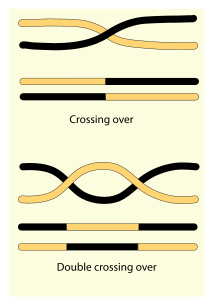
- Metaphase I - The chromosomes are attached to tthe spindle fibres and are arranged in a line on the equator of the spindle.
- Anaphase I - The chromatids from each of the homologous chromosomes are pulled apart by the spindle, and the cell membrane begins to close and part in the centre. Which chromatid from each chromosome is pulled into each new cell is random.
- Telophase I - The spindle disappears as two new, genetically unique cells form.
Meiosis II:
- Metaphase II - The spindle forms and the fibres attach to the chromosomes, which are arranged in a line on the equator of the spindle.
- Anaphase II - The chromatids separate to each end of the spindle - which chromatid is pulled into each new cell is random. At this point the diploid number becones haploid because the cell is splitting into 4.
- Telophase II - The spindle disappears and four new, genetically unique haploid cells are formed.
Types of Variation
There are three sources of variation:
- sexual reproduction (crossing over, independent assortment, fertilisation)
- immigration (however, this does not cause variation if the entire gene pool is homozygous for the same allele.)
- mutation
SEXUAL REPRODUCTION - CROSSING OVER
This can occur during meiosis, in prophase I.
Crossing over is where segments of chromatids from homologous chromosomes break off anf recombine, resulting in chromatids with a new combination of alleles.
SEXUAL REPRODUCTION - INDEPENDENT ASSORTMENT
Meiosis results in 4 haploid cells - the daughter cells of the original diploid cells. And in forming these haploid cells, genetic variation can take place.
How? - In both anaphases where the chromatids are separated, the orientation of the chromatids is random. This means that there are many, many possibilities for the distribution of the chromatids in the new haploid cells.
SEXUAL REPRODUCTION - FERTILISATION
For any given species there is a great number of female gametes, and a great number of male gametes. This means an even greater number of possibilities of fertilisation and therefore genetic variation.
MUTATION
A mutation is the change in genetic material that persists unchanged over successive generations.
Mutations are increasingly being seen as the most significant source of genetic variation.
There are a few different types of mutation:
- Point mutation - when only 1 or 2 nucleotides are changed, by deletion, insertion, substitution or inversion (alleles are locked together).
- can occur randomly or be induced by something called a mutagen.
- Chromosome mutation - larger parts of a chromosome are affected, by inversion, deletion or duplication.
- occurs randomly in nature.
- Translocation - a piece of chromosome breaks off and joins onto another chromosome.
- Transposons - literally, jumping genes, where genes change their loci on a chromosome.
Gregor Mendel
The namesake of Mendelian Genetics, Gregor Mendel began the research that would lead to our better understanding of genetics today.
MONOHYBRID CROSSES
Mendel's experiments began with monohybrid crosses of different plants:
- These consider only one pair of contrasting traits.
- He used only 'pure-breeding' varieties, meaning that if they self-fertilised they would only produce descendants identical to them.
He found:
- Both parents make an equal contribution to their offspring.
- F1 plants had the same phenotype but a different genotype to their parents, shown by them not breeding true to their visible trait.
- The visible trait in the F1 generation is dominant and the non-visible trait recessive - meaning it could appear in F2.
- The principle of segregation: every individual carries pairs of alleles for each trait and these alleles segregate (separate) - so a gamete can carry only one of each gene pair.
INDEPENDENT ASSORTMENT IN DIHYBRID CROSSES
Dihybrid crosses are, as the name states, similar to monohybrid crosses, but consider two pairs of contrasting traits instead of one.
Based on these experiments Mendel wrote his second law - the principle of independent assortment: two alleles of a gene segregate independently of the alleles of other genes.
Punnett Squares
Punnet squares are used to show the possible genotypes fromed when crossing alleles carrying contrasting traits.
Monohybrid cross (one pair of contrasting traits):
Dihybrid cross (two pairs of contrasting traits):
Pedigree Charts
These enable us to find whether a trait is dominant or recessive, and also how a specific gene will affect a population.
Applications of Genetics - Selective Breeding
Applications of Genetics - Cloning
Applications of Genetics - Genetic Manipulation
Glossary
A
Adenine
One of the bases present in nucleic acids (D.N.A. and R.N.A.). [1]
Allele
One of a number of alternative forms that a gene can take. [1]
Allele frequency
The proportion of an allele in a gene pool compared with all the alleles at that locus. [2]
Autosome
A chromosome not concerned with the determination of sex. [2]
C
Centromere
The part of a chromosome which attaches to spindle fibres during cell division. [1]
Chromatid
One of two produced by replication of a chromosome, held together at the centromere. [1]
Chromosome
A length of D.N.A. consisting of many genes. [1]
Complementary pairing
Relationship between bases in D.N.A., in which adenine pairs with thymine and guanine pairs with cytosine. [1]
Continuous variation
Variation which shows many different values. [3]
Cytosine
One of the bases present in nucleic acids. [1]
D
Dihybrid cross
Cross between true-breeding varieties differing with respect to two contrasting traits. [1]
Diploid
Having two sets of chromosomes, two of each kind. [1]
Discontinuous variation
Variation in which individuals can be divided into discrete classes. [1]
D.N.A.
The genetic material of all organisms except some viruses. [1]
Dominant
An allele is dominant if it is expressed in heterizygotes as well as homozygotes. [1]
E
Enzyme
Catalyst that speeds up biochemical reactions; almost all are proteins. [1]
F
F1 generation
Result of crossing two different pure-breeding varieties. [1]
F2 generation
Result of inbreeding an F1 generation. [1]
Fertilisation
The formation of a zygote by the joining together of two gametes. [1]
Founder effect
Change in allele frequency due to chance, as a small group of 'founders' becomes isolated from the main population. [1]
G
Gamete
Haploid cell that cannot develop further until it has fused with another. [1]
Gene Pool
All the genes in a population. [1]
Gene
The fundamental unit of inheritance; a section of D.N.A. coding for a polypeptide. [2]
Genetic bottleneck
Period in which a population is reduced to very small numbers, resulting in inbreeding and the loss of much of its genetic diversity. [2]
Genetic drift
Random changes in allele frequency due to chance, only significant in small populations. [1]
Genome
The entire set of genes of an organism. [1]
Genotype
The genetic makeup of an organism. [1]
Guanine
One of the bases present in nucleic acids (D.N.A. and R.N.A.). [1]
H
Haploid
Having one set of chromosomes. [1]
Heterozygous
Having two different alleles of a gene at a given locus. [2]
Homologue
One of two chromosomes that can pair up during meiosis; homologous chromosomes are nearly always similar in size and carry genes controlling similar processes. [1]
Homozygous
Having two of the same allele; true-breeding for a given trait. [1]
I
Inbreeding
Mating between close relatives. [1]
K
Karyotype
A test where the chromosomes in a cell from a specific organism are rearranged into an order, to find the number and type of chromosomes in that organism.
L
Locus
Position on a chromosome occupied by a gene (pl. loci) [1]
M
Meiosis
Nuclear division in which the number of chromosomes is halved. Results in gametes in animals and spores in plants. [1]
Mitosis
Nuclear division resulting in daughter nuclei genetically identical to the parent nucleus. [1]
Monohybrid
Formed by crossing two pure-breeding parents differing with respect to one pair of contrasting traits. [1]
Mutation
A change in the genetic material that persists unchanged over successive generations. [1]
N
Natural selection
Process by which some genotypes have higher reproductive success than others. [1]
Nucleotide
Sub-unit of nucleic acid (D.N.A. or R.N.A.), a chain of many nucleotides forming a nucleic acid. [1]
P
Phenotype
The observable characteristics of an organism; the physical expression of the genes. [1]
Pollination
Transfer of pollen from an anther to a stigma of the same species. [1]
Polymorphism
The occurrence of two or more distinct variants in a population, the frequency of the rarest being higher than that which could be due to the recurrent mutation. [2]
Polynucleotide
A chain of many nucleotides joined together. [1]
R
Recessive
An allele is recessive if it is only expressed in homozygotes. [1]
S
Segregation
Separation of homologous chromosomes or allelic genes during meiosis. [1]
Selection
Situation in which certain genotypes leave more surviving offspring than others, thus making a greater contribution to the gene pool. [2]
Spindle
System of protein fibres that moves chromosomes during nuclear division. [1]
T
Test cross
Method of determining an organism's genotype, by crossing it with a homozygous recessive. [1]
Thymine
Base found in D.N.A. but not R.N.A. [1]
Trait
A feature of an organism. [3]
Z
Zygote
The diploid product of fusion of two gametes. [1]
References
- [1] Excellence in Biology - A textbook for year 12 students.
- [2] Confidence in Biology - A student workbook for N.C.E.A. level 2
- [3] N.Z. Pathfinder Series - Biology Y12
- Biozone Year 12 Biology
- AME NCEA Level 2 Year 12 Biology Workbook
- NCEA Level 2 Biology - Year 12 Study Guide
- Pass With Pearson: NCEA Level 2 Biology 2.3
